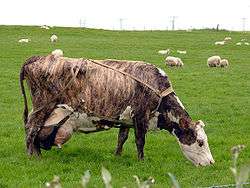Icelandic cattle

Icelandic cattle are a breed of cattle native to Iceland. Cattle were first brought to the island during the Settlement of Iceland a thousand years ago.[1] Icelandic cows are an especially colorful breed with a wide variety of colours and markings.[2] Icelandic cattle have been genetically isolated for centuries, but are most closely related to breeds in Norway called Blacksided Trender and Nordland Cattle.[3] No cattle are permitted to be imported into Iceland so they have been protected by strict disease-prevention measures.[4]
The Icelandic cow is a dairy breed with a small body-size. About 95% are naturally polled, but the rest are horned. An average cow can produce about 6,000 kg (13,200 lb) of milk per year, with the best animals producing 11,000 kg (24,300 lb). They are housed for about eight months of the year and fed largely on hay, supplemented with cereals. They are outside grazing in the summer, and to prolong the growing season, cabbage, turnips, barley and oats are grown for forage.[1] There are fewer than 30,000 cows on the island and their milk is used to create a mild, butter-flavoured cheese.[5]
According to a report produced by the Agricultural University of Iceland, it would be more cost-effective to replace Icelandic cattle with Swedish cattle as the latter produce more milk at a lower cost.[6] However, some have argued that Icelandic cattle are part of Iceland's cultural heritage and should not be replaced.[7][8]
Guðni Ágústsson, former Icelandic minister of agriculture, once kissed an Icelandic cow.[9]
The milk from Icelandic cows is used to make skyr.[10]
See also
References
- 1 2 "Our colourful Icelandic cows". Retrieved 28 October 2007.
- ↑ van Rensburg, Jaco. "CATTLE BREEDS -- ICELANDIC". Retrieved 28 October 2007.
- ↑ "Where did the Icelandic horse originate?". Vísindavefurinn. Retrieved 17 November 2007.
- ↑ "Nature's Spectrum in a Variety of Products" (PDF). Mjólkurvörur í sérflokki. Archived from the original (PDF) on 19 June 2006. Retrieved 17 November 2007.
- ↑ Andrew Evans (1 August 2014). Iceland. Bradt Travel Guides. pp. 63–. ISBN 978-1-84162-499-0.
- ↑ "Iceland's Cows May Be Replaced with Swedish Breed". Iceland Review. Retrieved 28 October 2007.
- ↑ B., Sara (29 October 2007). "Whole Milk". Iceland Review. Retrieved 29 October 2007.
- ↑ Þorkelsson, Bjarni (2006). "This speech was given Bjarni Þorkelsson at the FEIF Conference 2006" (PDF). FEIF Conference. Retrieved 29 October 2007.
- ↑ "Cow kissing minister wants to preserve Icelandic cattle stock". Iceland Review. 19 October 2005. Retrieved 17 November 2007.
- ↑ "A Tasty Cultural Revolution: With All The New Types Of Yogurts For Sale, How Can You Know Which One Is Best For You?". CBS News. 29 September 2007. Retrieved 17 November 2007.
External links
- Inga Thorsdottir, Bryndis Eva Birgisdottir, Inga Maria Johannsdottir, D. Paul Harris, Jeremy Hill, Laufey Steingrimsdottir, Arni V. Thorsson (October 2000). "Different β-Casein Fractions in Icelandic Versus Scandinavian Cow's Milk May Influence Diabetogenicity of Cow's Milk in Infancy and Explain Low Incidence of Insulin-Dependent Diabetes Mellitus in Iceland". Pediatrics.
- Birgisdottir BE, Hill JP, Harris DP, Thorsdottir I. (August 2002). "Variation in consumption of cow milk proteins and lower incidence of Type 1 diabetes in Iceland vs the other 4 Nordic countries.". Diabetes Nutr Metab.
- Differences in cow's milk composition between Iceland and the other Nordic countries and possible connections to public health
- "THE BISHOP’S BEEF: Improved Cattle in Eighteenth Century Skálholt, Iceland" by George Hambrecht, Stanford Journal of Archaeology